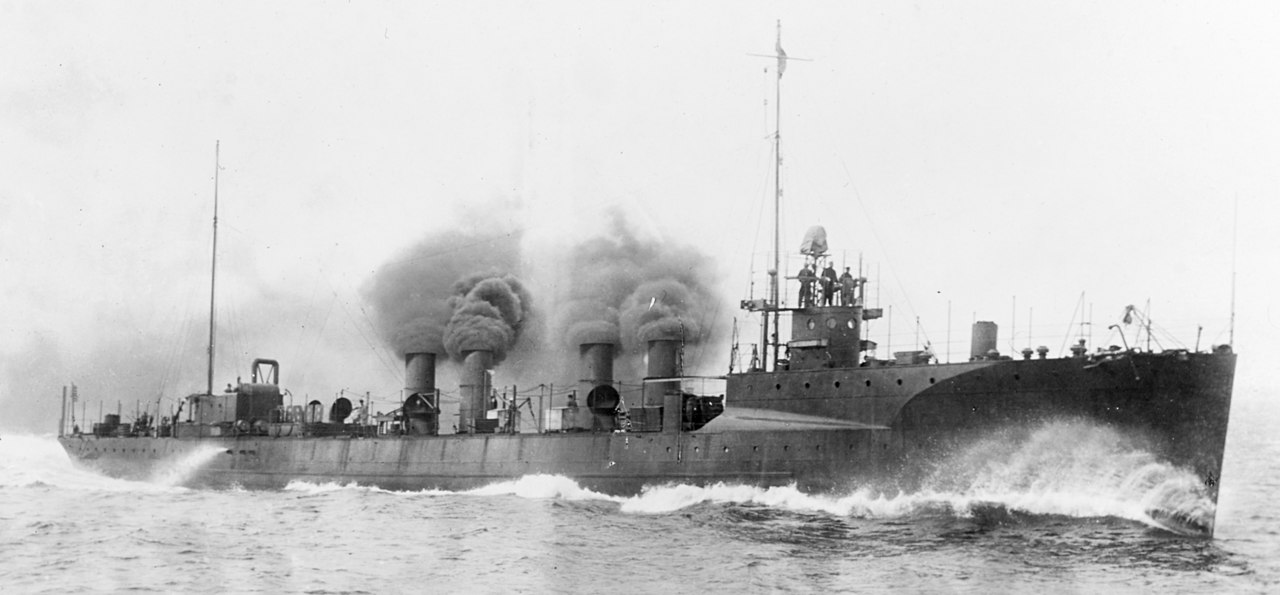
The Turbines Destroyers or “Flivvers”
The Smith and Paulding were closely similar fleet destroyers nicknamed “flivvers” restrospectively after the after the small and shaky Model T Ford after the 1000-tonners entered service. But they were a landmark: The first USN steam turbine fleet destroyers. A first class of five ships Smith, Lamson, Preston, Flusser, Reid, and a further nineteen of the Paulding class, quite similar. There were larger, with a forecastle and turbines, compared to the Bainbridge class, and completed in 1909-1910. All served as convoy escorts in World War I, several attacked U-boats but they were discarded soon after the war.
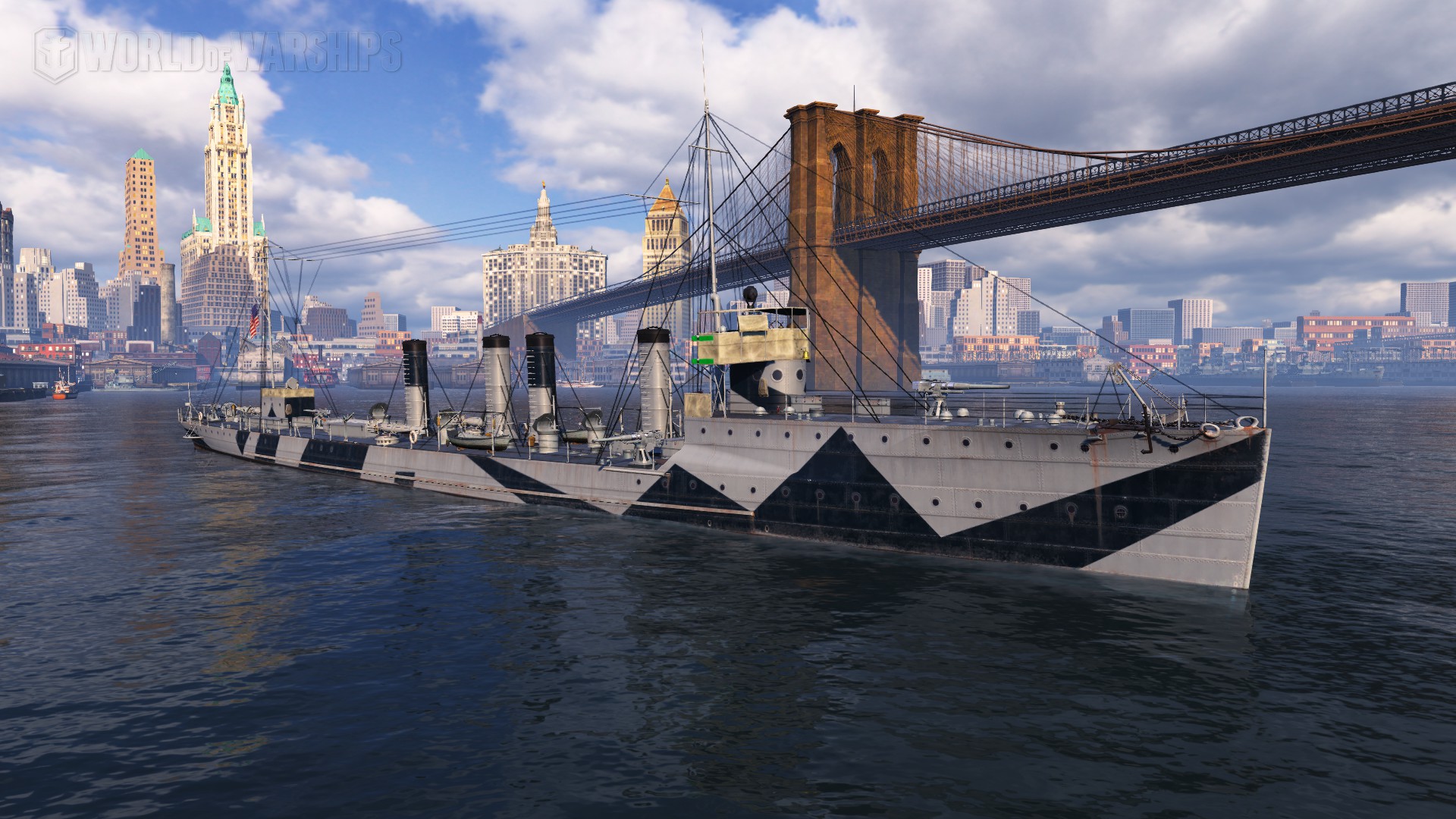
Smith Class Design
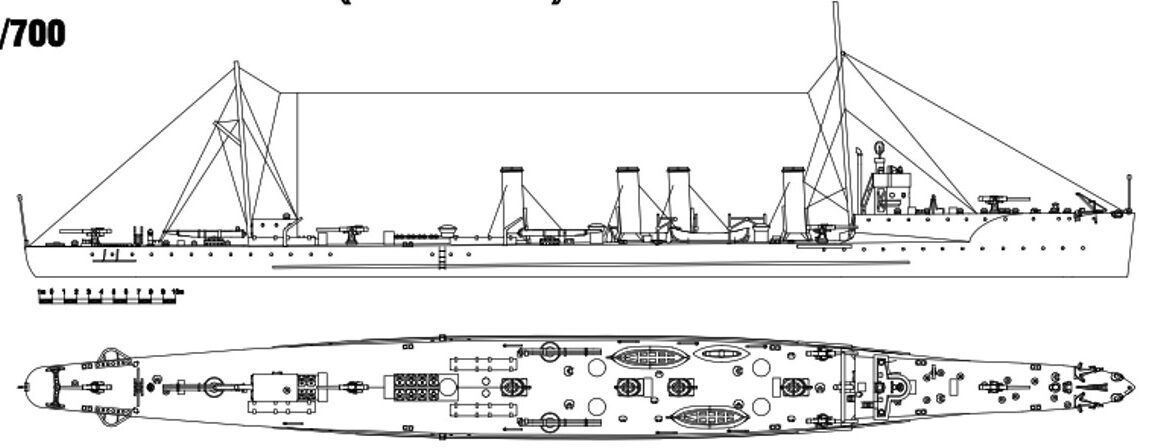
Reconstitution of the class, USS Smith, 2 side views (Kombrig)
The Smith-class destroyers were the first ocean-going destroyers in the United States Navy, and the first to be driven by steam turbines instead of the reciprocating engines fitted in the sixteen earlier and much smaller torpedo boat destroyers ordered in 1898. But they were also the last coal-fired. Flusser and Reid are sometimes considered to be Flusser-class ships. Also, since Flusser was completed first, some period documentation refers to the entire class as Flussers. They were also innovative on several other points and mirrored a general upgrade in fleet destroyer design seen throughout the world, like the Russian Novik in 1911. But in 1905, the RN laid down HMS Swift under the guidance of admiral Jackie Fisher. Compared to the plucky 1903 River class, this was a monster at 1,825 tons (2,207 tons full load), capable (on paper) of 34 knots, also “announcing the color” for flotilla leaders and future developments.
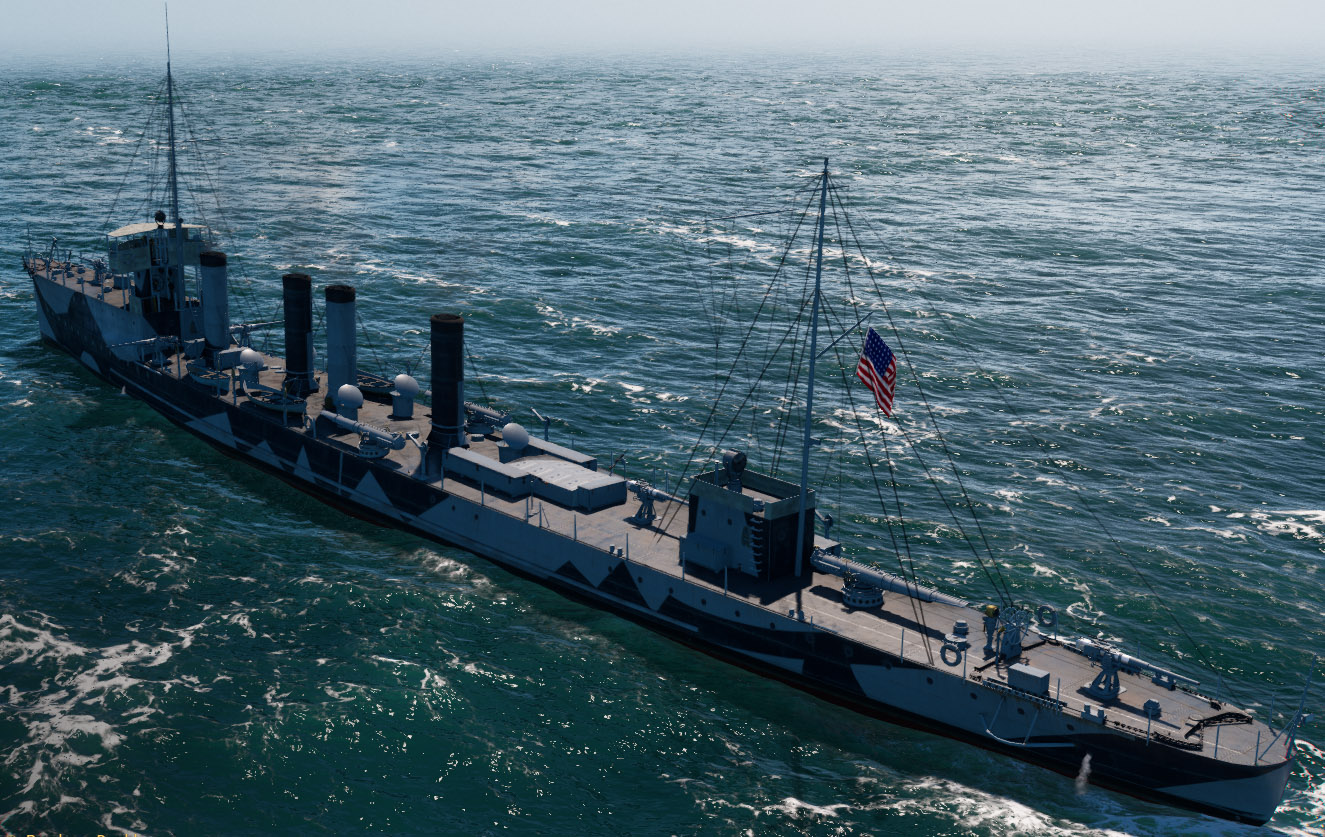
A 1906 order
The first three of the Smith class were ordered under the Act of 29 June 1906 and it was specified that they needed to have the “highest practical speed, and to cost, exclusive of armament, not to exceed seven hundred and 50,000 dollars each”. The last two were ordered under the Act of 7 March 1907 with the same but not to exceed 80,000 dollars each.
Initially the admiralty did not specified any powerplant requirements. So Yards competiting for the design order had freedom between VTE and Turbines. The choice of turbines was not dictated by speed and weight issues, but surprisingly by cost: Indeeed, when bids were opened, turbine-powered proposals were cheaper than VTE proposals.
As designed by the master yard, William Cramp & Sons, Philadelphia, the Smiths class were basically, greatly enlarged Truxtuns, with 900 tons fully loaded, 50% larger. The extra displacement was a reserve to add extra armament and a larger machinery in order to keep the same top speed as before, 28-knot (52 km/h; 32 mph). Also with a greater lenght went the advantage of better wave riding, whereas seakeeping was considerably improved by the adoption of a raised forecastle, even taller than on the Bainbridge class that received that Forecastle to improve seaworthiness.
The search for Long Range
To go with the greater machinery and the benefit of a longer and wide hull, coal capacity was massively increased, to 304 tons, almost half the total fully loaded displacement of the Truxtun class ! This extra range provided them with new capabilities unseen in the USN: The admiralty had in hands its first truly ocean-going destroyers. Or “fleet destroyers” as they proved this time able to cover and screen the battlefleet on long voyages.
One explanation for the adoption of this new type of destroyer, often referred at by authors, was the seizure of the Philippines after the Spanish–American War of 1898 and acquisition of Hawaii, a central place in the Pacific, both the same year. They shown the need for long-range ships, and all classes were affected by this: Battleships, cruisers, and naturally destroyers. Even before the Smith class entered service the US experienced with its long range abilities through the Great White Fleet in 1907–09. This really confirmed this was the right path. Still, despite being impressive for their time, when the 1913 new 1,000 tonners (Cassin class) entered service, they went with the “flivvers” sobriquet in reference to to small and shaky Model T Ford.
Replacing Torpedo Boats
It was recognized for the first time that hunting torpedo boats were not anymore the prime objective of these fleet destroyers, unlikely to cross them during their long voyages, but rather to engage otrher fleet’s own destroyers screening. They would had also to take over the role of torpedo boats, too short range, with a more offensive, heavier torpedo capability. Thise made them, in addition to be the first sea-going USN destroyers, the first multi-missions US destroyers as well. In 1917 was added to this, ASW warfare. They were a main reason why torpedo boats ceased to be considered by the naval staff. The last were the Blakeley class ordered in May 1898, last started in 1901.

The Paulding class, to compare (Kombrig)
Design of the class
Hull and general design
The Smith class really were impressive ships compared to the previous Truxtun/Bainbridge especially. As customary at the time, the hull had no uniform framed section amidship but a gradual profile with fine entries and stern lines for maximum penetration. The greatest beam (26 ft or 7.92 m) was reached aft of N°4 funnel, and on a 293 ft 10 inches long hull (89.56 m) this made for a 1/10 ratio. The ships were overall rather narrow due to this progressive framing (modern destroyers had a fuller hull form). The draft was still rather limited at 8 ft (2.44 m), allowing to enter most waters, including rivers (Mississippi and Great Lakes) if needed.
The poop was rounded, sloped downwards. The forecastle was taller than on the previous Bainbridge class for better seakeeping.
The protect the hull from still common collisions at the time, they had two hull bars close to the waterline and two framed bumpers aft, at the height of the propellers. The superstructures were reduced to the bare minimum: A bridge forward, containing a small map room and the open bridge above, fitted with the chadburn and all necessary acoustic tubes for internal communication. Despite being well above water in rough weather, the whole structure was covered by a canvas. The forecastle’s flanks were indented with recessed to enable to bear forward the first two deck guns. The last two were located aft, axial. There was another small quarterdeck room aft, with the base on the mainmast. Only three rowing boats, located along funnel N°2-3 were installed for liaison and safety.
Powerplant

Cutaway of the class by A.D. Baker III in 1910. Scanned from U.S. Destroyers: An Illustrated Design History by Norman Friedman.
Unlike the earlier sixteen destroyers, the new “800-tonners” had triple propellers shafts, for three turbines. These turbines were of the direct drive (not geared) type. They were arranged like on the older British Turbinia: H high-pressure turbine (center shaft) was exhausting to two outer, low-pressure turbines driving the outboard shafts. This means they acted as auxiliaries when cruising, with added turbines on the outboard shafts for better fuel economy at low speeds, the central, axial turbine being shut down. High consumption however was still a problem until two breakthroughs: Oil, and higher steam pressures/temperatures.
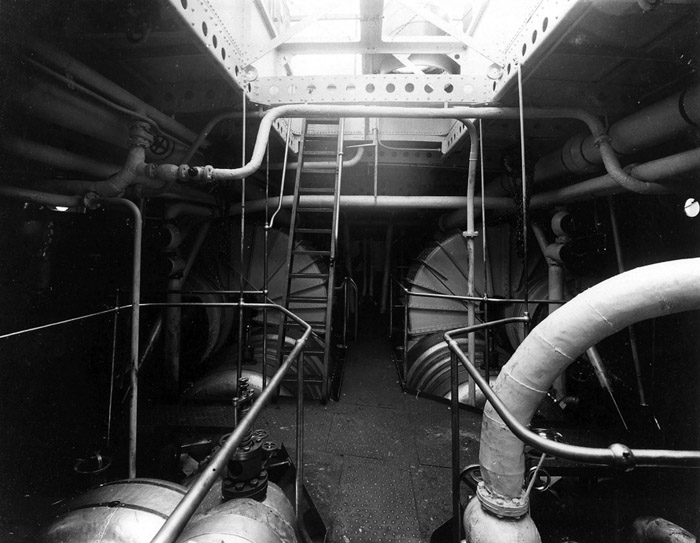
Machinery of USS Flusser – navsource.org
Engineers tried to solve the discrepancy between the turbine’s high efficient speed and propeller’s low efficient one and a compromise 724 rpm shaft speed was found, wtill twice that of a modern vessel. The location of the boilers dictated two widely spaced pairs of funnels. The very ship, USS Smith, though, had its first and fourth funnels further apart than the central pair. She also had four Mosher coal-fired boilers for a totall output of 10,000 shp (7,500 kW), reaching on trials 28.35 knots (32.6 mph; 52.5 km/h) based on an output of 9,946 shp (7,417 kW). She also carried 304 tons of coal.
Armament
Compared with the Truxtuns, the main armament was considerably increased, to five 3-inch (76 mm)/50 caliber guns. This was done at the detriment of lighter armament, and so more standardized, making it easier to work with. The trend here was no American but set in Britain, with the rearmament of the British River-class destroyers in 1906 and a reflection of the concept behind HMS Dreadnought. To go with the torpredo capabilirty, a third 18-inch (457 mm) torpedo tube was added, and three reloads, one for each tube, six torpedoes total.
Main
The 3″/50 caliber gun Mark 2 was prioneered in 1898 and soon became a staple of light artillery in the USN, spreading into all manner of ships types. They were judged superior to the British 3-in Armstrong Elswick. They could have been upgraded later during completion to the Mark 5, or 6. There are some confusion between sources and the types installed could have been either the 76/50 Mk III, Mark V or Mark VI. In any case, they fired a 24 lb (11 kg) complete round at 2,700 ft/s (820 m/s) with medestal mounts which elevates to 15°, and allows 20 rpm in optimal conditions. Max range was probably 8,000 yards.
Torpedoes
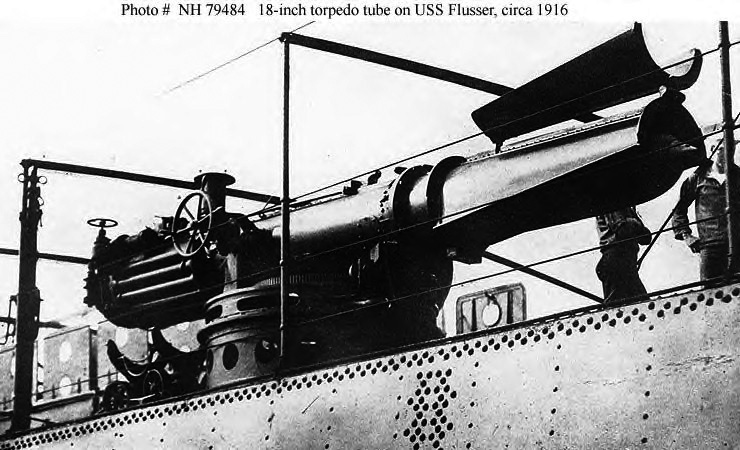
These three tubes were located on either side of the amidghsip funnels for the first pair, on the broadside, and a third aft of the mainmast, close to the helmswhell and aft gun. It was later realized that this placement was less than idea as stern launches above 20 knots caused the torpedo to run erratically due to the stern wave deflection.
The torpedo types fired were most probably the Whitehead 18″ (45 cm) Mark 5. They were the first with three speed settings. Weighting 1,452 lbs. (659 kg) for 204 in (5.182 m) long, they carried a
199 lbs. (90 kg) wet gun-cotton warhead, for 4,000 yds/27 kts or 2,000 yds/36 kts and 1,000 yds/40 knots, powered by a dry heater system (hot running) connected to a four cylinder reciprocating engine. It was “guided” by a Mark 1 Mod 3 gyro system.
Modifications
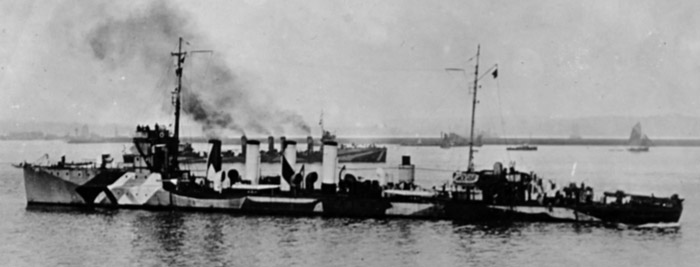
USS Benham and Lawson in the background, showing her 1918 camouflage.
So in 1916, the single torpedo tubes were removed and replaced by two twin mounts with no reloads. These new mounts actually weighed less than the older single ones. A single 3-inch gun was removed and to complete this in 1917-18, two depth charge racks were added at the poop for convoy escort.

Author’s HD illustration of the Smith class
⚙ specifications |
|
| Displacement | 700 long tons normal, 902 long tons full load |
| Dimensions | 293 ft 10 in x 26 x 8 ft (89.56 x 7.92 x 2.44 m) |
| Propulsion | 3 shafts Parsons DD Steam Turbines, 4 Mosher coal-fired boilers 10,000 shp (7,500 kW) |
| Speed | 28 knots (52 km/h; 32 mph) |
| Range | Range 304 tons coal, 2,800 nm (5,200 km) at 10 knots |
| Armament | 5×3 in (76 mm)/50, 3×18 in (450 mm) TTs, 6 Torpedoes |
| Crew | 4 officers+ 83 ratings |
Read More
Books
Bauer, K. Jack; Roberts, Stephen S. (1991). Register of Ships of the USN, 1775–1990: Major Combatants. Greenwood Press.
Friedman, Norman (2004). US Destroyers: An Illustrated Design History (Revised ed.). NIP
Gardiner, Robert; Gray, Randal (1985). Conway’s All the World’s Fighting Ships 1906–1921
Silverstone, Paul H. (1970). U.S. Warships of World War I. London: Ian Allan.
Links
On destroyers.org
Smith class on destroyerhistory.org
The flivvers on destroyerhistory.org
navsource.org
3-in guns on navweaps.com
Pre-WWI US Torpedoes – Navweaps
On Navypedia
Wiki
additional photos (navsource):
Smith
Lamson
Model Kits
 Smith DD-17
Smith DD-17
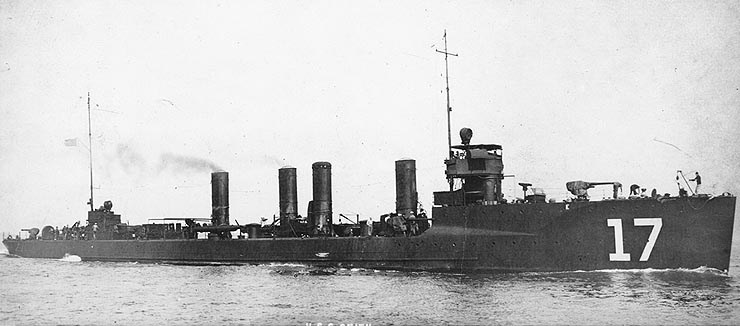
USS Smith was built at William Cramp & Sons, Philadelphia, laid down on 18 March 1908, launched 20 April 1909, comm. 26 November 1909. Attached to the Atlantic Torpedo Fleet but in reserve by October 1912. Reactivated (reduced crew) by December 1915; Neutrality Patrols off Boston, then in New Orleans (10 December) for recruiting, Naval Auxiliary Reserve. Based in Key West (12 February 1916), New York (15 February) always recruiting.
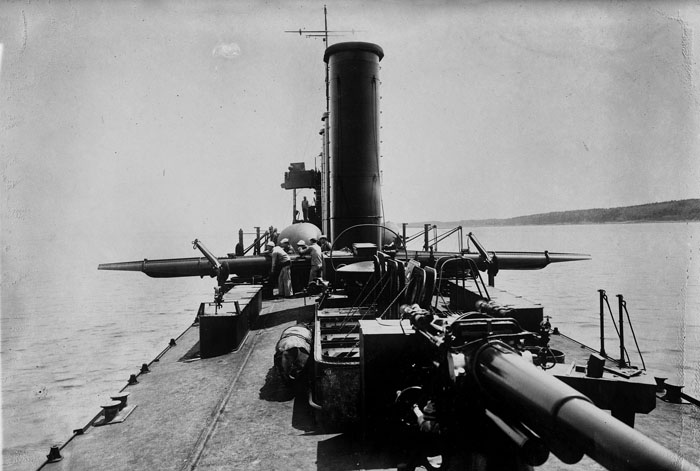
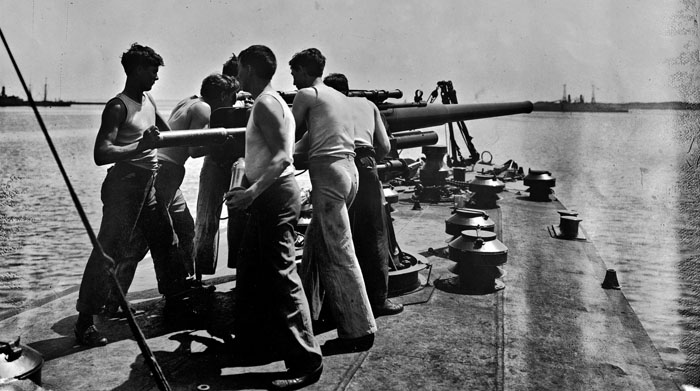
Gunnery and torpedo drills aboard USS Smith, date unknown (navsource)
After preventing German ships to escape New York or scuttle she departed to join the Patrol Force along the East Coast (10 April-14 May) reporting on the 17 April a submarine sighting. After her overhaul at Charleston NyD from 17 May to 16 July, she departed for Bermuda and patrolled three months in the Azores (26 July-5 October) until reaching her new home port, Brest, France on 20 October. Until V-Day she escorted eastbound and westbound convoys on 500 mi (800 km) westward of Brest. She only had sightings of suspected subs and attacks but no kills but rescued survivors like on 31 May 1918, 240 men from President Lincoln and on 1st July, she rescued survivors from Covington.
Her Inter-war career was fairly short: After an overhaul in UK until 3 November she stayed in Brest until 2 April 1919, during which time she escorted home bound troop transports. She was back in May at Philadelphia, decommissioned (2 September) sold on 28 February 1920, but requisitioned by BuC&R for bombing experiments. This started on 18 September, and until 5 Novemner in Chesapeake Bay (with USS Indiana and G-1). She survived, was towed back to Philadelphia, then became a bombing target on 20 July 1921 and eventually sold on 20 December to Henry A. Hitner’s Sons Co. and BU.
 Lamson DD-18
Lamson DD-18
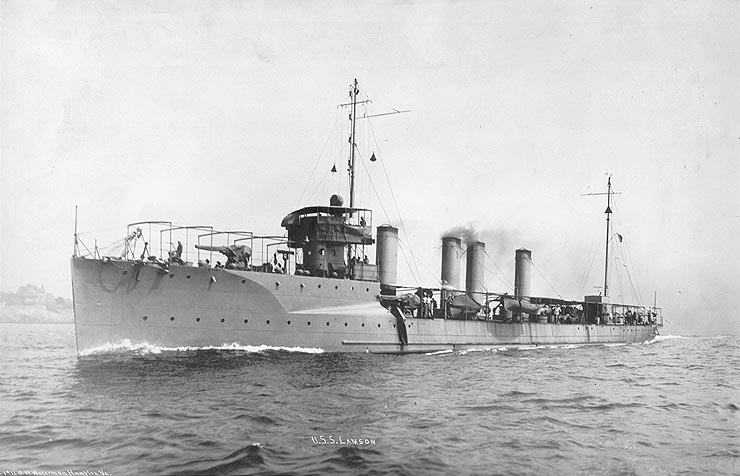
USS William, built in Cramp & Sons, was laid down on 18 March 1908, launched 16 June 1909, completed 10 February 1910. Assigned to the Atlantic Squadron, Lamson operated along the east coast and in the Caribbean from 1910 to 1916 participating in torpedo exercises, fleet maneuvers, and coastal patrol. Departing Key West, Florida on 7 May 1916, the destroyer arrived Dominican Republic two days later to support the Marines sent by President Woodrow Wilson to protect American interests during the Dominican revolt.
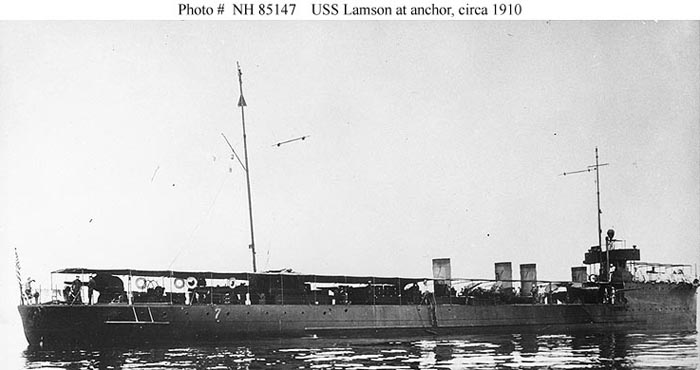
USS Lamson in 1910
She returned to Key West in mid-June before sailing on the 28th for Vera Cruz. She joined other American ships in Mexican waters, as the Mexican political situation was still in turmoil. Following her return to Key West on 11 July, Lamson operated along the east coast and in the Gulf of Mexico until the United States entered World War I.
During the early months of the war, she patrolled the coastline before preparing for oversea service. Arriving Ponta Delgada, Azores on 26 July 1917, the destroyer performed escort and patrol duty for the next three months. Lamson departed the Azores on 6 October for escort operations out of Brest, France. She assisted survivors of Finland on 28 October after the merchant ship had been torpedoed by a German submarine.
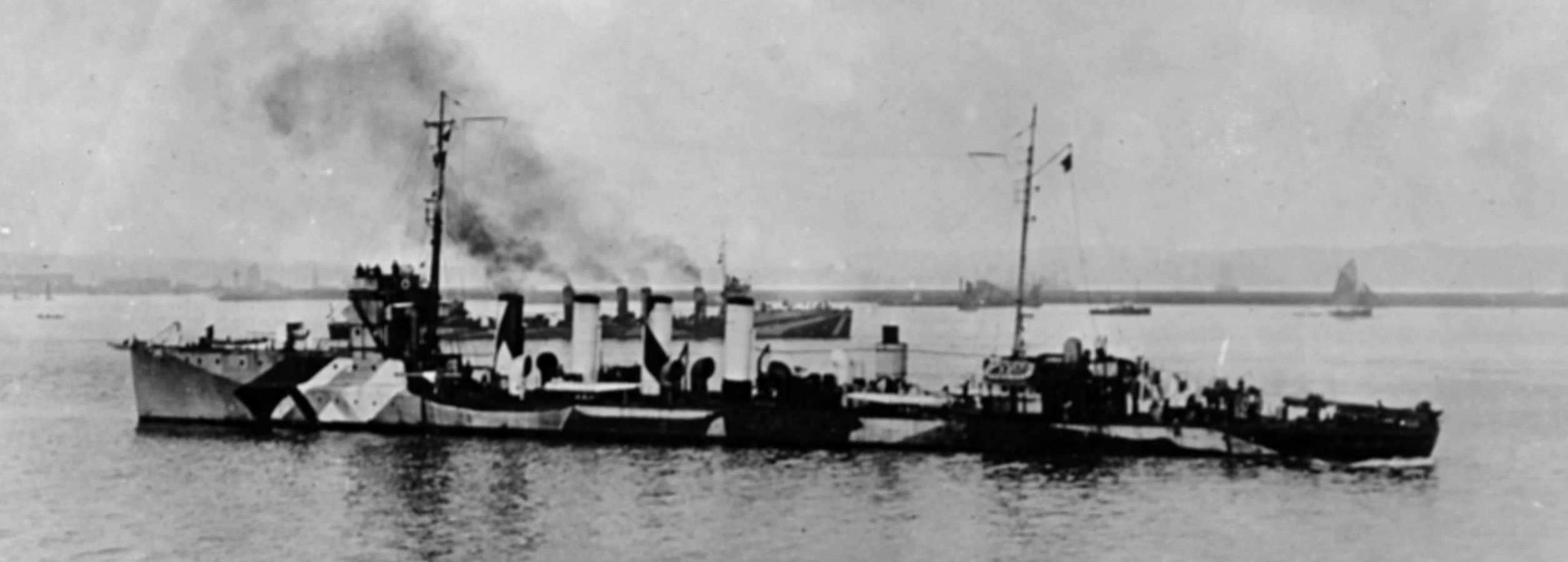
USS Lamson in 1918
The destroyer continued escort and patrol operations for the rest of the war, and aided in the victory of Allied forces by neutralizing the German U-boat threat to convoys. After the Armistice, Lamson departed Brest on 11 December 1918 and arrived at Charleston, South Carolina on 31 December. She decommissioned on 15 July 1919 and was sold on 21 November.
 Preston DD-19
Preston DD-19
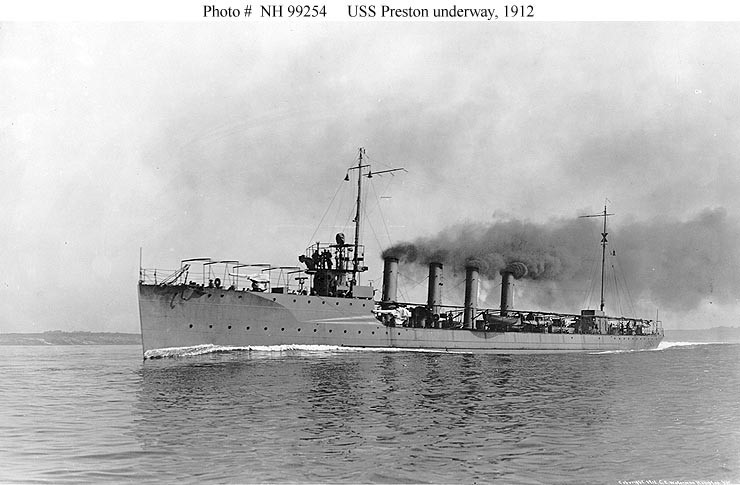
USS Preston as completed, showing the early, spartan “open bridge” of the whole class. After their major overhaul they were fitted with an enclosed bridge.
Built at the New York Shipbuilding, Camden in New Jersey, she was laid down on 28 April 1908, launched 14 July 1909 and commissioned on 21 December 1909, with Lieutenant commander George C. Day in command. Attached to Destroyer Force, Atlantic Fleet, at first she spent her time in peacetime patrols in various squadron cut by fleet exercises. Then from 1917 she was in neutrality patrols, based in New York.
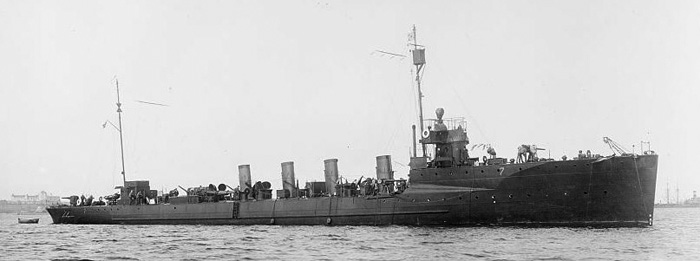
USS Preston in dark grey livery, 1910
From 6 April 1917 she headed for Boston and went on patrolling the east coast until 12 May before going back to the Destroyer Force, Atlantic, for coastal escorts until July. From there, she patrolled from Europe, and until October she was based in the Azores. She ended in Brest until the end of the war for the first leg of escort from Europe. On 11 December 1918, she departed for home, arriving at Charleston in South Carolina on 4 January 1919. Transferred to Philadelphia she was decommissioned on 17 July, stricken on 15 September and sold for BU on 21 November at T. A. Scott of New London in Connecticut.
 Flusser DD-20
Flusser DD-20
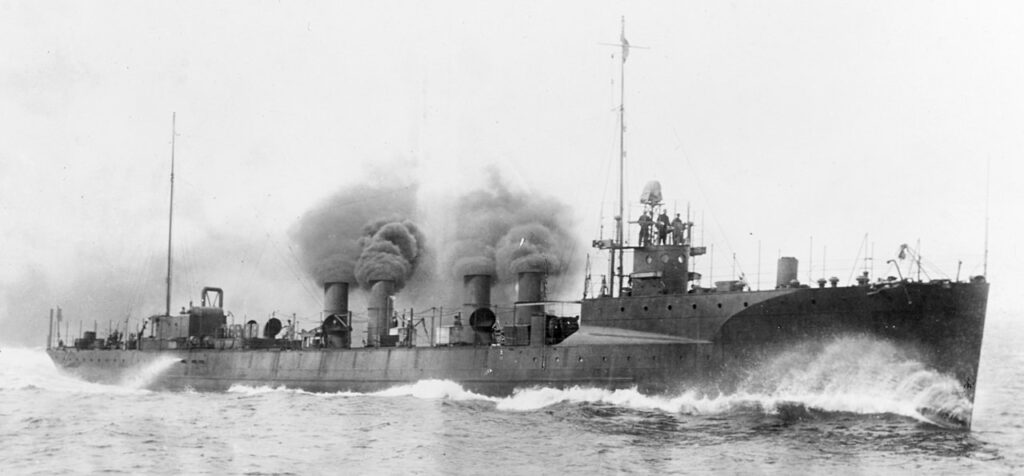
USS Flusser was built at Bath Iron Works in Maine. She was laid down on 3 August 1908, launched on 20 July 1909 and completed on 28 October 1909. She is often referred as her own sub-class with USS Reid. Her first captain was Lieutenant William Henry Allen (12 October 1911-August 1912) followed by Lieutenant William Halsey, Jr. (August 1912-5 September 1913 and yes, the one).
USS Flusser was based first at Charleston, South Carolina from 17 December 1909, starting her peactime routine of East Coast Atlantic Torpedo Fleet duties and yearly cruising in winter in the Caribbean up to the coast of New England.
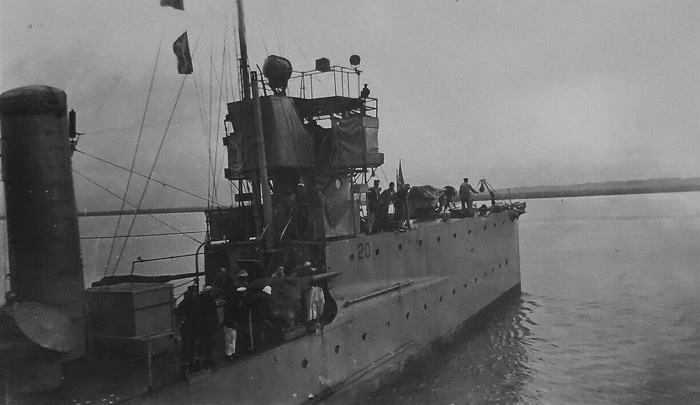
USS Flusser, rear view, details of the forecastle and bridge (navsource)
This went on until August 1916, followed by neutrality patrols off New York and Long Island. After an overhaul in New Orleans in 1917, she resumed east coast escort until 30 July and started ocean escort/patrol missions from Ponta Delgada in the Azores, the USN “mid-atlantic” spot.
Later she was based in Brest, France, to patrol the English Channel (22 October-9 December 1918). She returned to Charleston after the war on 31 December to be decommissioned at Philadelphia on 14 July 1919, sold fpr BU on 21 November.
 Reid DD-21
Reid DD-21
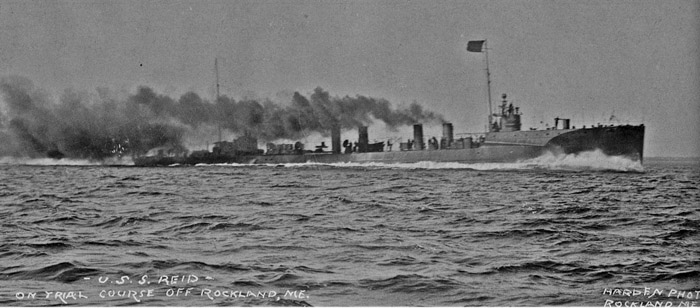
USS Reid on sea trials off Rockland, Maine
Like Flusser, Reid was built at Bath Iron Works. She was started on 3 August 1908, launched on 17 August 1909 and completed on 3 December 1909. Sge was assigned to the Atlantic Torpedo Flotilla, and operated along the east coast between drills and training exercises. From April 1917 she fell under command of Ensign Charles Alan Pownall.
On 6 April she took part in the “Southern Patrol Force” based in Key West, Florida. On the 18th she was assigned to Squadron 1, Patrol Force from Boston, the Squadron 2 in eMay, to the northeast coast and on 15 May joined the Destroyer Force escorting incoming traffic off New York. Next she was reassigned to Charleston, prepared for overseas service and sailed on 21 July to the Azores, escorting convoys-midway there until 30 September.
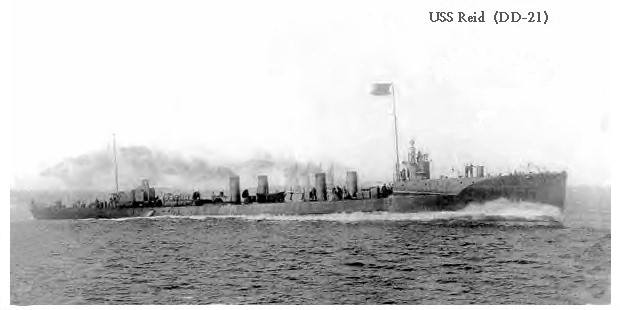
In October, she was based in Brest, and on the 23rd she was accidentally rammed and damaged by the freighter W. T. James. Repaired at Brest, she resuled her escort work until November 1918. She spotted and attacked several U-Boats, most notably UB-55 on 18 March 1918 and U-86 on 1 July, but only caused damaged.
USS Reid departed Brest for Charleston in December. Inactivated on the 31st, she was moved Philadelphia, to be decommissioned on 31 July 1919, then stricken on 15 September, sold to T. A. Scott & Co. of New London for BU on 21 November.

 Latest Facebook Entry -
Latest Facebook Entry -  X(Tweeter) Naval Encyclopedia's deck archive
X(Tweeter) Naval Encyclopedia's deck archive Instagram (@navalencyc)
Instagram (@navalencyc)





 French Navy
French Navy Royal Navy
Royal Navy Russian Navy
Russian Navy Armada Espanola
Armada Espanola Austrian Navy
Austrian Navy K.u.K. Kriegsmarine
K.u.K. Kriegsmarine Dansk Marine
Dansk Marine Nautiko Hellenon
Nautiko Hellenon Koninklije Marine 1870
Koninklije Marine 1870 Marinha do Brasil
Marinha do Brasil Osmanlı Donanması
Osmanlı Donanması Marina Do Peru
Marina Do Peru Marinha do Portugal
Marinha do Portugal Regia Marina 1870
Regia Marina 1870 Nihhon Kaigun 1870
Nihhon Kaigun 1870 Preußische Marine 1870
Preußische Marine 1870 Russkiy Flot 1870
Russkiy Flot 1870 Svenska marinen
Svenska marinen Søværnet
Søværnet Union Navy
Union Navy Confederate Navy
Confederate Navy Armada de Argentina
Armada de Argentina Imperial Chinese Navy
Imperial Chinese Navy Marinha do Portugal
Marinha do Portugal Mexico
Mexico Kaiserliche Marine
Kaiserliche Marine 1898 US Navy
1898 US Navy Sovietskiy Flot
Sovietskiy Flot Royal Canadian Navy
Royal Canadian Navy Royal Australian Navy
Royal Australian Navy RNZN Fleet
RNZN Fleet Chinese Navy 1937
Chinese Navy 1937 Kriegsmarine
Kriegsmarine Chilean Navy
Chilean Navy Danish Navy
Danish Navy Finnish Navy
Finnish Navy Hellenic Navy
Hellenic Navy Polish Navy
Polish Navy Romanian Navy
Romanian Navy Turkish Navy
Turkish Navy Royal Yugoslav Navy
Royal Yugoslav Navy Royal Thai Navy
Royal Thai Navy Minor Navies
Minor Navies Albania
Albania Austria
Austria Belgium
Belgium Columbia
Columbia Costa Rica
Costa Rica Cuba
Cuba Czechoslovakia
Czechoslovakia Dominican Republic
Dominican Republic Haiti
Haiti Hungary
Hungary Honduras
Honduras Estonia
Estonia Iceland
Iceland Eire
Eire Equador
Equador Iran
Iran Iraq
Iraq Latvia
Latvia Liberia
Liberia Lithuania
Lithuania Mandchukuo
Mandchukuo Morocco
Morocco Nicaragua
Nicaragua Persia
Persia San Salvador
San Salvador Sarawak
Sarawak Uruguay
Uruguay Venezuela
Venezuela Zanzibar
Zanzibar Warsaw Pact Navies
Warsaw Pact Navies Bulgaria
Bulgaria Hungary
Hungary

 Bundesmarine
Bundesmarine Dutch Navy
Dutch Navy Hellenic Navy
Hellenic Navy Marina Militare
Marina Militare Yugoslav Navy
Yugoslav Navy Chinese Navy
Chinese Navy Indian Navy
Indian Navy Indonesian Navy
Indonesian Navy JMSDF
JMSDF North Korean Navy
North Korean Navy Pakistani Navy
Pakistani Navy Philippines Navy
Philippines Navy ROKN
ROKN Rep. of Singapore Navy
Rep. of Singapore Navy Taiwanese Navy
Taiwanese Navy IDF Navy
IDF Navy Saudi Navy
Saudi Navy Royal New Zealand Navy
Royal New Zealand Navy Egyptian Navy
Egyptian Navy South African Navy
South African Navy






























 Ukrainian Navy
Ukrainian Navy dbodesign
dbodesign